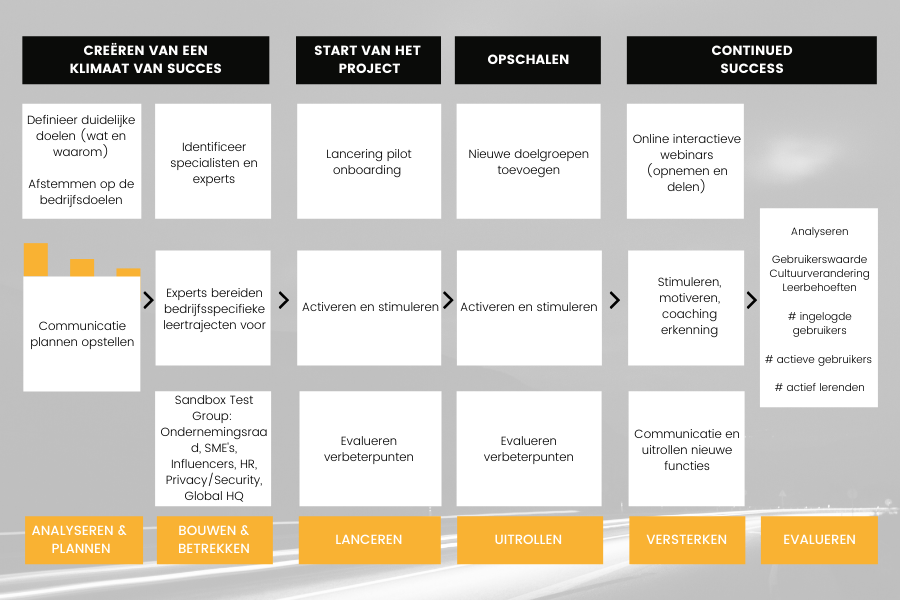The four phases of LXP implementation; Hans Ramaker likes to oversee the whole process.
The Learning Experience Platform (LXP) is the solution for many companies. However, implementing a successful LXP does not happen overnight. It requires time, patience and dedication. Hans Ramaker, our Senior Implementor Learning Innovation takes you through the four phases of implementation. Hans likes to oversee the whole process and guides companies like an (imple)mentor.
"The great thing about implementing is that you need a very big view of the organization. Both top down and bottom up. One of the key conditions of success is the flexibility of managers and employees. I like to help people become flexible so they can keep up with big changes. In my experience, every organization goes through four phases when implementing the LXP."
Phase 1: Create climate of success
"A good problem analysis and a clear measurable goal are the basis, the foundation on which you enter into the LXP implementation process. Don't look at existing resources, think solution-oriented. Once the foundation of the process is in place, communicate enthusiastically about the new vision and learning technology. Present the innovations as a gift. Communicate the plans, the overall timeline and the "what's in it for me" for both managers and employees.
What I sometimes see at large companies is that a problem analysis is done at a high level. Then the problem is chopped up and, through various layers of management, only a small part ends up in the HR department. They do not know the whole picture and cannot possibly contribute to solving the big problem.
So communication is invaluable. Above all, be creative. Think of an inspiring name for the LXP with a positive connotation and create a nice corporate identity for recognition. For managers, you can create an additional communication package with videos or a sneak peak to arouse curiosity."
Phase 2: Start project- Pilot
"Put together a pilot group that gets to use the LXP first. Above all, present that as a privilege. Who you absolutely must hook up with? The influencers from your organization, specialists, the business council, HR and Privacy & Security. The latter is hugely important for the rollout. Social Learning is one of the pillars within the LXP, a lot of knowledge and information will be shared. Privacy & Security knows what is allowed and possible within your company. If they are only hooked up at a later stage, this can cause resistance and delay. I have seen several companies withdraw an implementation after phase 2. It takes a lot of time and energy to rectify that afterwards.

You take the pilot group through the vision behind the LXP and show why every employee can benefit from it. This is how you create an initial group of supporters. Once they share their enthusiasm with other employees, the desire to participate will grow. We encourage that with communication. You can then admit other employees to the system drop by drop or wait for the big launch. That launch date does need to be known so that it can be looked forward to. Keep the enthusiasm warm."
Phase 3: Scaling up
"The moment is here: everyone can be in the LXP. Make it a celebration. Communicate that the organization is investing in employees and why it is so important for everyone's own development. Ask members of the pilot group to write blogs or record videos to encourage use of the LXP. Be creative in sharing successes.
Meanwhile, keep an eye on the data. Check how many users are logging in and actually doing something on the LXP. Activation is incredibly important. People come back once they've discovered the value of the platform."
Step 4: Continued success
"In the beginning, there will be a lot of logging into the LXP. The line rises sharply. Then it flattens out and if you don't do anything then it collapses. To avoid that, it is important to strengthen the base. Sharing best practices from users is very effective. Data also plays an important role. You can see how often people log in, what users consume, what they search for and how much information they share. Using this data, you can encourage employees in all areas. For example, share what the best-read blog is and communicate new features of the platform. In short; don't miss any opportunity to draw positive attention to the LXP.
Evaluation may not be the most popular step but it is an important one. Test whether set goals are being met. Adjust KPIs and test again. Only then will you know if your LXP implementation is a success. Analyze the data generated by the system and evaluate its use among employees. You will learn from this and it will help you keep renewing the LXP and thereby improve employee development."
The goal of the LXP is not to keep the platform alive but to allow users to develop. So never lose sight of the focus on development in communications."
The four phases in view
Below you can see the four phases of a successful LXP implementation visualized:
Help or experiences?
"Are you in the middle of an LXP implementation and could use some help? Or do you have valuable experiences with an LXP implementation that are definitely worth sharing? I'm very curious. Let me know!"
Ps. Within Next Learning Valley, we have our own LXP within the Learning Suite: StreamLXP. Want to learn more about that? Then don't hesitate to contact us.
